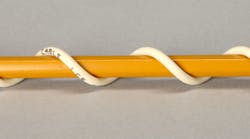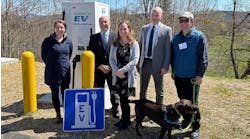Fiber that bends around pencils and sharp corners without a significant increase in attenuation has captured the collective imaginations of fiber pundits everywhere. From discussions on conference floors to meeting rooms to the proverbial water cooler, these fibers are touted as virtually indestructible — a perception that leads to some potential problems.
The new breed of reduced bend radius fibers can reduce minimum bend radius requirements from the traditional 10 times the outside diameter of the jacketed cable (about 38 mm) to as low as 5 mm to 10 mm without increasing attenuation. A monumental breakthrough in the fiber community, this capability conjures up all kinds of possibilities for technicians and installers, particularly in fiber-to-the-premises (FTTP) applications.
Today, the greatest need for these fibers is in high-density cable management products for FTTP applications. In addition, they will undoubtedly be used in new and legacy wavelength division multiplexing (WDM) installations, which are also gaining traction within the access segments of the network, including WDM passive optical networks (WDM-PONs).
It is now possible to use these reduced bend radius fibers in outside plant, central office, headend, and premises locations because cable structures have evolved to provide physical protection for the internal fibers, which allows them to maintain their optical performance characteristics for high signal quality.
It's still glass
The danger is that technicians may believe these new fibers are impervious to the forces that increase attenuation or cause optical links to fail. Even the names given to some of these fibers, such as bend insensitive, bend resistant, and bend optimized, can lead technicians to make false assumptions about the fiber's durability and performance capabilities — assumptions that could have a serious impact on long-term network performance.
The fact that a fiber can be bent beyond traditional limits doesn't mean it can't be damaged. In the end, it's still fiber (still glass, if you will) — a substance that's subject to fracturing and even breaking with improper handling or other outside forces. Not all types of cables ensure against kinking, although advances are being made in cable structures as well. Some new cable designers will actually provide built-in bend limits to protect the glass within.
What is most exciting about these fibers is that they will make installation, particularly routing of cables inside structures, much easier. For example, it will be much easier to route and conceal the fiber cable between rooms and around sharper corners in a multiple dwelling unit. However, even with simplified fiber cable management techniques, it's necessary to plan carefully for a robust, reliable network. The way fiber cables are connected, terminated, routed, spliced, stored, and handled will still have a direct and substantial impact on network performance and, more importantly, profitability.
Four elements of good fiber cable management include: bend radius protection, cable routing paths, accessibility, and physical protection. Let's take a look at how each element should be considered in light of the capabilities of the latest reduced bend radius fibers.
Bend radius protection
In the past, bend radius protection was arguably the most important aspect of good fiber management because it prevented the macrobends that drastically reduce the network's long-term performance. Reduced bend radius fiber and improved jacketing techniques now allow much sharper bends without attenuation penalties. However, bend radius protection is far from a thing of the past.
Although the new fibers enable less stringent parameters, there still a minimum bend radius technicians must consider. Proper slack storage is a critical step in alleviating potential problem areas on frames and along cable pathways.
Technicians must understand that these new fibers do not diminish the need for solid fiber cable management practices. Instead, the increase in the number of fibers being added to optical access networks to accommodate broadband upgrades makes bend radius protection more important than ever. This, in turn, requires good cable routing, because improper fiber routing is a major cause of bend radius violations.
Cable routing paths
Although some technicians may believe neatness is no longer required because new fibers make bend radius protection obsolete, nothing could be further from the truth. First, as we discussed earlier, bend radius protection is far from obsolete. Second, good cable routing is needed for more than simply reducing bend radius violations. Technicians are still required to perform rapid circuit routing, cable tracing, and reconfigurations.
Good cable routing permits clearly defined and easy-to-follow pathways. On the other hand, cable routing that is left to the technician's imagination leads to an inconsistent, difficult-to-manage network. Cable routing quality makes all the difference between congested chaos and neatly placed, easily accessible patch cords. Well-defined routing paths also reduce the proficiency training time required for technicians.
Reduced bend radius fibers will magnify the benefits of good cable routing. While defined routing paths make it easier to access individual fibers, the new fibers will enable technicians to actually put their hands into a fiber bundle to physically trace a particular fiber. This will make cable tracing much easier and reduce the time required for reconfigurations. However, any benefit provided by reduced bend radius fibers will depend on how well the cables were routed in the first place.
Cable connector access
Cable access, the third element of good fiber cable management, refers to the accessibility of the installed fibers and connectors. If technicians assume that bending fibers to gain access is no longer a problem with reduced bend radius fibers, they can actually make cable access more difficult.
In FTTP architectures, connectors are closely packed together, making the possibility of accidentally disconnecting a wrong cable much greater. Whatever type of fiber is used, connector access is critical for reconfigurations, rapid service turn-up, testing, troubleshooting, and dealing with customer churn.
In the past, an active equipment rack might have had 50 fibers exiting it, so the management of individual fibers was much less of an issue. But as that same rack is fitted for broadcast services, the number of fibers increases to upward of 500, making proper management and accessibility techniques critically important. The bottom line is that reduced bend radius fibers have little effect on reducing the need for ensuring good cable and connector access for technicians.
Physical fiber protection
The physical protection of fiber cannot be stressed enough to technicians and installers. The tighter bending capabilities of new fiber products do not diminish the need to protect fibers from outside forces. Optical fiber is still glass, and damaged — or even broken — fibers are still a possibility if the fiber is handled roughly or improperly.
Whether or not fibers bend around corners, they will always have the physical limitations imposed by their cladding and cover materials, which are still covering a glass core. They are still subject to serious damage from nails, screws, staples, and external pressure or mishandling that causes pinching, binding, or bending the fiber beyond its capabilities. Therefore, all fibers traversing from one piece of equipment to another must be physically protected, for example, by raceway systems.
Technical skill levels
Service providers have asked whether they can employ less-skilled technicians to deploy these new fibers, since sensitivity to the special handling of these cables is less of an issue. But the issue isn't really whether reduced bend radius fibers should be handled different from other fibers — they should not. Rather, the issue is the installer's experience. Even though copper cable is simpler to handle, very few people prefer having it installed by inexperienced technicians. They prefer to have the job done correctly and in accordance with building codes, standards, and specifications.
This leads us to the subject of standards. Although some standards have emerged for the fibers themselves, standards concerning installation techniques are lacking, leaving technicians and installers at the mercy of the manufacturer's specifications. Technicians cannot, and should not, make assumptions about fiber, because the fiber and cabling could come from different manufacturers. Therefore, until standards are written for proper installation and handling of these new fibers, the potential exists for confusion about what is acceptable and what is not — and erring on the side of caution should be the rule.
Even technicians with many years of experience in fiber installation face the challenges of proper fiber handling and cable management techniques for all types of fiber. There is currently no way to identify which optical cables contain reduced bend radius fibers and which do not. Therefore, technicians and installers should always use prudence with good cable installation disciplines, regardless of the fiber and cable types installed. If this point is minimized, long-term performance is jeopardized. Problems could occur in many legacy fiber installations that are not designed with these new fibers, and thus are not as bend resistant.
Today's users already have difficulties in identifying fiber-optic cable types and characteristics. As densities continue to increase with a mix of older and newer cable plants installed, it will become even more difficult for technicians to determine which fibers may be more bend resistant. Therefore, the safest practice would logically be to apply traditional fiber management techniques across the board regarding bend radius, security, and routing of optical cables, jumpers, and fibers.
In fact, some new fibers call for special attention or knowledge on the part of technicians. For example, some types of reduced bend radius fibers, known as “holey fiber,” are manufactured with nanostructures, or small airholes around the fiber's core. These airholes can actually wick water or alcohol on the endface while they are being cleaned in preparation for splicing or connectorization. If the technician is aware of these fibers, he or she will know to cut the fiber back a bit before immediately splicing it. Similarly, in field connectorizations, there are some new techniques required for the new reduced bend radius fibers. Technicians must be aware of any special requirements associated with different types of fiber.
Educating technicians
Reduced bend radius fiber is not a completely new phenomenon — some types have been on the market for several years. However, these fibers are steadily being improved to enable technicians to install them faster, more easily, and with the same or better reliability. But, as with all their predecessors, these new fibers have limits that technicians must understand and adhere to.
Reducing the traditional bending radius allows many benefits to installers. New jacket materials will likely improve these fibers even more. With each improvement, however, comes the responsibility to ensure that technicians are aware — not only of the benefits of a new fiber but, more importantly, of its limitations. Good fiber and cable management techniques, along with the use of quality cable management products designed with the long-term viability of network performance, will become even more critical in the days ahead as fiber densities reach an all-time high.
New reduced bend radius fibers, together with the elements of good fiber cable management, will significantly enhance long-term performance and efficiency for optical access networks. If technicians “bend” the rules and practices of managing the fiber because they believe new fibers allow them to do so, network efficiency and performance is jeopardized in the process. It all starts with education — and ensuring that the network designer, installers, and technicians are acutely aware of the capabilities of the products placed in their hands.
Smith is the program manager for FTTX solutions at ADC, headquartered in Eden Prairie, Minn. Johnson is founder and president of The Light Brigade, a fiber-optic training organization headquartered in Tukwila, Wash.



